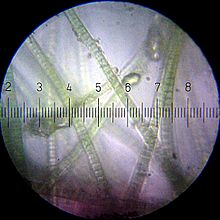
Back تثبيت الكربون Arabic Fixació del carboni Catalan Kohlenstoffdioxid-Assimilation German Fijación de carbono Spanish تثبیت کربن Persian Fixation du carbone French Fixación do carbono Galician Fiksasi karbon ID Fase di fissazione del carbonio Italian 炭素固定 Japanese

Biological carbon fixation, or сarbon assimilation, is the process by which living organisms convert inorganic carbon (particularly carbon dioxide) to organic compounds. These organic compounds are then used to store energy and as structures for other biomolecules. Carbon is primarily fixed through photosynthesis, but some organisms use chemosynthesis in the absence of sunlight. Chemosynthesis is carbon fixation driven by chemical energy rather than from sunlight.
The process of biological carbon fixation plays a crucial role in the global carbon cycle, as it serves as the primary mechanism for removing CO2 (carbon dioxide) from the atmosphere and incorporating it into living biomass. The primary production of organic compounds allows carbon to enter the biosphere.[1] Carbon is considered essential for life as a base element for building organic compounds.[2] The element of carbon forms the bases biogeochemical cycles (or nutrient cycles) and drives communities of living organisms.[2] Understanding biological carbon fixation is essential for comprehending ecosystem dynamics, climate regulation, and the sustainability of life on Earth.[3]
Organisms that grow by fixing carbon, such as most plants and algae, are called autotrophs. These include photoautotrophs (which use sunlight) and lithoautotrophs (which use inorganic oxidation). Heterotrophs, such as animals and fungi, are not capable of carbon fixation but are able to grow by consuming the carbon fixed by autotrophs or other heterotrophs.
Six natural or autotrophic carbon fixation pathways are currently known. They are the: i) Calvin-Benson-Bassham (Calvin Cycle), ii) Reverse Krebs (rTCA) cycle, iii) the reductive acetyl-CoA (Wood-Ljungdahl pathway), iv) 3-hydroxy propionate [3-HP] bicycle, v) 3-hydroypropionate/4- hydroxybutyrate (3-HP/4-HB) cycle, and vi) the dicarboxylate/ 4-hydroxybutyrate (DC/4-HB) cycle. [1] "Fixed carbon," "reduced carbon," and "organic carbon" may all be used interchangeably to refer to various organic compounds.[4]
- ^ a b Santos Correa S, Schultz J, Lauersen KJ, Soares Rosado A (1 May 2023). "Natural carbon fixation and advances in synthetic engineering for redesigning and creating new fixation pathways". Journal of Advanced Research. 47: 75–92. doi:10.1016/j.jare.2022.07.011. hdl:10754/680126. ISSN 2090-1232.
- ^ a b Santos Correa S, Schultz J, Lauersen KJ, Soares Rosado A (1 May 2023). "Natural carbon fixation and advances in synthetic engineering for redesigning and creating new fixation pathways". Journal of Advanced Research. 47: 75–92. doi:10.1016/j.jare.2022.07.011. hdl:10754/680126. ISSN 2090-1232.
- ^ Berg JM, Tymoczko JL, Stryer L (2013). "Stryer Biochemie". doi:10.1007/978-3-8274-2989-6.
{{cite journal}}: Cite journal requires|journal=(help) - ^ Geider RJ, et al. (2001). "Primary productivity of planet earth: biological determinants and physical constraints in terrestrial and aquatic habitats". Global Change Biology. 7 (8): 849–882. Bibcode:2001GCBio...7..849G. doi:10.1046/j.1365-2486.2001.00448.x. S2CID 41335311.
© MMXXIII Rich X Search. We shall prevail. All rights reserved. Rich X Search